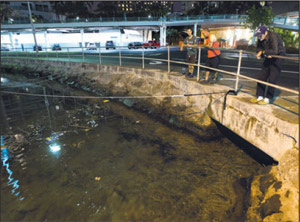No Such Thing As A Fake Tsunami

Visitors and Oahu residents watch the ocean water surge into Ala Wai Harbor carrying various debris during a tsunami Oct. 27 in Honolulu. The water dropped about a foot then came up a foot in about 30 seconds. The first waves of a tsunami hitting Hawaii on Saturday night hit shore smaller than expected roughly three hours after officials ordered evacuations of all coastal areas threatened after a powerful earthquake off the coast of Canada. AP photo/Eugene Tanner
Why is that so hard for some of us to understand? Instead of being grateful that Mother Nature spared our island chain Oct. 27, many played Monday morning quarterback (on Monday), and criticized the decision for coastal evacuations during our latest tsunami scare.
It’s easy to pass judgement with the benefit of hindsight, but some of the comments made on social media sites Sunday morning makes you wonder, what’s happened to our Hawaii?
For those of you who called the event a “fake tsunami” or “another example of government and media overreacting,” please take a moment to think about what you’re saying.
Yes, the tsunami warning notice was delayed and seemingly came out of nowhere, and there were missteps taken by emergency officials that exposed flaws in our siren warning and tsunami buoy systems, but to say the evacuations were a waste of time and money is incredibly irresponsible. And that’s not even addressing the issue of those who chose not to heed the warnings and continued to walk the beaches.
A magnitude 7.7 earthquake is more than capable of generating a destructive tsunami. The one that hit British Columbia’s west coast that Saturday was the largest quake in Canada in more than six decades, and it did trigger a tsunami.
Gerard Fryer of National Oceanic and Atmospheric Administration’s Pacific Tsunami Warning Center says, “There is nothing between Canada and us that would scatter the energy, so once the beam is formed, it just points right to us.”
Hawaii appeared to be the target of that beam of energy, so a tsunami warning was rightfully issued. There were too many uncertainties not to issue one. Thankfully, the waves that arrived across the state were much smaller than anticipated, and no major damage was reported.
As I waited in the checkout line at the grocery store early Sunday morning, I was appalled to hear two young men say, “We always get the fake tsunamis in Hawaii, I wish one day we get the big one!”
Are you kidding me? It took every ounce of energy in my body not to say anything. Perhaps it’s because I saw death and destruction at ground zero at Ishinomaki less than a month after the devastating earthquake and tsunami struck Japan.
Or was it the memory of watching a mother beg Japanese authorities huddled at a shelter to help her find her missing daughter, or the sound of a screaming father who had to be restrained after his son was pulled from the rubble near his elementary school?
Believe me, there’s nothing exciting about a tsunami. Moving water is one of the most powerful elements on this planet, and can and will destroy anything in its path.
While science has come a long way, it is obvious there is still much we don’t know. Those who collect and study the data understand that when it comes to nature, there will always be unknown variables.
This latest scare has given all of us, including government agencies, the opportunity to reassess our disaster preparedness plans and addresses our warning system flaws. It’s our kuleana to learn from our mistakes. Instead, I’ve heard the moaning and groaning. “The traffic was horrible.” “We had to cancel our party.” “It was such an inconvenience!” Really?
We should be thankful we were able to return to our homes and sleep in our own beds less than six hours after the tsunami warning.



